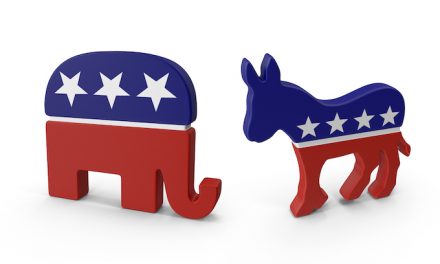The Democratic party is dying. That may be hard to believe since Democrats control both houses of Congress and won the last presidential election with a record 81 million votes. But the exiguous margins of their hold on the House and Senate, with fewer than 51 per cent of the seats in either chamber, tell another story, as does the desperation of their struggle to abolish the filibuster and federalise election law.
Those policy aims are of a piece with dreams of ‘packing’ the Supreme Court with left-liberal justices — and packing the Senate too, by turning tiny Democratic bastions into new states. The left wing of the party even assails the constitutional principle behind the Senate itself, the idea of equal representation of the states.
Simply put, Democrats know they can no longer win by the old agreed-upon rules, constitutional or otherwise. As recently as the Obama years, they were content with a system of 50 states represented by two senators each — because the party still had a wide enough base of support to win the Senate with an outright majority. They had taken control after 2006, amid the wreckage of George W. Bush’s forever wars, and kept it until 2014. Barack Obama’s coat-tails in 2008 were strong enough for him to take off with 57 Democrats in the Senate and a majority of nearly 80 seats in the House.
Joe Biden had no coat-tails in 2020, even though he won 12 million more votes than Obama did in 2008. The 81 million who voted for him — or against Donald Trump — didn’t give Democrats a majority in the Senate, and Republicans actually made gains in the House. Do Puerto Rico or Washington, DC have a better case for statehood today than they had in 2009? What changed? Nothing about PR or DC, but everything for the Democrats.
The party is dying because it has a demographic problem. Long after the culturally revolutionary New Left had carved its way into what was once a working-class party, bringing not only acid, amnesty and abortion but yuppie economics and new strains of identity politics, voters in what are now red states could still feel a connection to the party of FDR or JFK. Bill Clinton looked a little Kennedy-esque, didn’t he? And Joe Biden is some sort of Irish Catholic, right? How bad could they be? Very bad indeed, to judge by the long-term cultural and economic effects of the Clinton years, and the early moves of the Biden administration. Clinton signed Nafta into law and exported American jobs while importing low-skilled labour, the illegal variety included.
The prosperity resulting from a short technology boom disguised just how much damage Clinton had done to middle America’s livelihood. In retrospect, the telecom-internet technological burst of the 1990s and 2000s looks like the last wave of the 20th century’s great tide of innovation, which had brought transistor radios, TVs, VCRs, the Walkman, personal computers and so much more. The flood has not ebbed completely, as iPhones and smart speakers attest, but these too may be residues of a truly Promethean century past, rather than intimations of a more promising future.
Irish American men are not going to be diverse enough for the Democratic party of tomorrow. Really they aren’t diverse enough for the Democratic party of today, but in 2020 Biden was the only candidate who seemed to stand a chance. Bernie Sanders, the runner-up, would have exposed how economically hard-left the party could be. And the party’s own black voters preferred Biden to Kamala Harris or Cory Booker. The party’s leadership problem isn’t about race: it’s that the Kennedy-esque image and ideology have had their last dance.
Yet demographics was supposed to save the Democratic party: a less white America, eventually a majority-minority America, would be a more Democratic America, maybe even a one-party America. This myth still drives the mostly white liberals who lead the Democratic party and the panoply of elite institutions — the mainstream media, the academy, corporate America — that keep the failing patient on his feet.
This is why race-baiting has become not only the most important stratagem but practically the only one that Democrats and their allies resort to in their public messaging. They try to terrify Asian Americans with insinuations that white Americans are targeting them with violence, when the reality is that whites, Asians, Hispanics, blacks and everyone else is most at risk from the lawlessness that Democrats have tolerated (and more than tolerated) in the cities under their control. As they make abundantly clear with every riot, the rising left wing of the Democratic party simply considers law enforcement the enemy. When their publicists write that they really and literally mean ‘Defund the police’, Americans of all races must believe them.
Despite the police shootings, the riots and the media’s constant racial hype, last year’s presidential election was less racially polarised than any since at least 2004. Trump, a man who Democrats and their allies perceive as the embodiment of white diabolism, actually won a greater percentage of votes from Hispanics and blacks than liberal-sensitive Republicans such as John McCain and Mitt Romney. And Trump achieved that amid a record-high turnout.
For well over two decades Republicans listened as the top pundits and political consultants told them that the only way to win more minority votes was to sound exactly like the Democrats: maybe talk about religion and inner-city empowerment zones a little, but whatever you do, don’t mention immigration or crime. Trump defied that conventional wisdom and made gains by doing so. Now Republicans may for the first time try a right-wing message to minorities, even as Democrats are devoured by the left.
Republicans have a long way to go before making any progress in the cities, of course, even as the cities suffer. Political machines aren’t dismantled easily. But if the GOP can make little headway in Democratic cities, the Democrats face the more serious problem of losing ground in the states. Hence the sudden panic about political arrangements they were content with until the day before yesterday. Biden is alive, but his party is dead. And the newborn radical Democrats can’t win — not without rewriting the rules to get around competition at the state level, where elections are closer to the people.
Copyright The Spectator (1828) Limited Apr 17, 2021
—-
This content is published through a licensing agreement with Acquire Media using its NewsEdge technology.



















Simply put, Democrats now know they can win while ignoring or attacking the old agreed-upon rules, constitutional or otherwise.
Fixed it for you.
You can tell when a party is dying when a large number of their votes come from the grave, and rolls of recent deaths. If only the living were counted their 81 million votes would have dropped to about 60. Add in the illegals who voted and it drops even further.
One just has to add up the down ticket votes and then you have the true vote count for the most corrupt lowest IQ POTUS who has made wrong decisions for the people of this country. for over 47 years.
Ya, the 81 million number is a total joke. There weren’t even enough dead to make up that number. I’m sure tons of them are double voting for the dead! In fact, this guys idea of what happened and why is so skewed I swear he’s a liberal (not a leftist, but from the supposedly JFK-esque wing he’s so fond of). The fact that he believes the anti-Trump vote was so large shows how out of touch he is with real conservative America. This skewed view extends to everything else he discusses including on what the “GOP” should do…as if the GOP leadership didn’t also screw the American people in the last election.
With all we’ve seen re voting machines turning TRUMP Votes into biden votes by the thousands in precinct after precinct, CAN WE REALLY TRUST he won with 81 million votes/?? I doubt he REALLY GOT even 50 million.
How is the Democrat party going to die, when the voting is rigged? Devin Nunes was on Maria Bartiromo’s show yesterday and he indicated that the intelligence community is going after military officers that are Republicans, so they can be removed from the military. We are now a communist nation, where Conservatives are criminals. The Supreme Court will be packed by the Democrat communists, Puerto Rico and Washington DC, will be states. The Democrats will have a majority in Washington DC forever.
HENCE Why all those conservative pundits i hear, who STILL SAY “we can still trust our military to do the right thing”, must be HIGH AS A KITE…..
WITH HOW rotten the entire leadership (an oxymorn) has become, i doubt we can trust even 1/3rd of it anymore… AND with the rate the left is doing their best to purge those patriots out, in a few more years, there won’t even be THAT THIRD we could trust…
“This is why race-baiting has become not only the most important stratagem but practically the only one that Democrats and their allies resort to in their public messaging. They try to terrify Asian Americans with insinuations that white Americans are targeting them with violence, when the reality is that whites, Asians, Hispanics, blacks and everyone else is most at risk from the lawlessness that Democrats have tolerated (and more than tolerated) in the cities under their control.
The dishonorable Democrat Party revolves around and its philosophy is based on Control, Hate, Lies, Cons, Deceptions, Immorality and the lack of Integrity, Ethics or Honor.
The Dishonorable, Democrat Party in the U.S. game plan is to lie, cheat and steal elections
in order to control the American people and bring American commerce and economy to its knees.
Then access power and retain it by any means available –
no matter the costs to the people, the government or the nation.
The Democrat Party’s Lies, Cons, Deceptions and division by hate, can only work if people are stupid enough to keep believing the Democrat Party’s Lies, Cons, Deceptions.
Sooner or later even stupid people wake up.
THING IS< with how the lies just keep spreading, while the truth dies out, i am not SURE These folk CAN BE "woken" up…
i beg to differ on that idea.
first off the gop shoved president trump under the bus and did not fight hard enough to overturn
election results in several states that were clearly loaded with fraud and deceit.
Hard work,honesty, good results are no longer winning qualifications, but the ability to deceive, hire a good mdia manipulator, and pack the vote counters at the polls which is just a prelude to packing the Supreme Court and you get elected as a Democrat with full party backing. If the only way to beat a beguiling dishonest Democrati is to not only become him, but out do him in corruption, the country is already lost. No police, no arrrests and with the crooked judges in your pocket even the ones caught red handed get let loose upon the innocent unsuspecting public who thanks to the media painting over the corruption, have no chance to organize to oppose them. You can’t even praise the Lord and pass the ammunition, because the govenment has taken over the supply. This will not end well or peacefully.
I believe there are many GOP politicians who are also Corrupt, Greedy or stupid. Just like many of the real people that voted for Biden.
I honestly believe, a large chunk of the GOP< wanted Trump gone, just as bad as the dems did.. MAYBE even more.. THAT IS WHY SO MANY Stabbed him (and we the voter) in the back.
What do you mean dying? It died at least a decade ago when it became the social-democrat party and continued to morph into the American Socialist part. They are all D.I.N.O.’s today. In fact as they continue to morph into the communist party of America, a large number have already become full fledged communists. There is nothing left to die, it has been dead for very many years. Democrat is actually an archaic term.
Can’t die fast enough—go ahead and give it a lethal injection.
And they did not win by 81 million votes—they stole the election with the help of computer programmers and a lot of fake ballots.
ANd **** tons of illegal aliens voting!
He certainly DID NOT get 81 million votes. Obama got way less than that and it was obvious he had some charisma and could at least draw a crowd. Was ANYONE PAYING ATTENTION when Biden had his “rallies”?? 25, 30, 100 people on a good day. Does anyone believe people were more smitten with old Joe than they were with Obama? Come on, man.
As they make abundantly clear with every riot, the rising left wing of the Democratic party simply considers law enforcement the enemy.
Political Science 101, Rule 1: Never, ever screw over your praetorians.
(Translated from the Latin of the Caesars.)